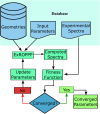Learning radical excited states from sparse data
- PMID: 40901619
- PMCID: PMC12400446
- DOI: 10.1039/d5sc04276c
Learning radical excited states from sparse data
Abstract
Emissive organic radicals are currently of great interest for their potential use in the next generation of highly efficient organic light emitting diode (OLED) devices and as molecular qubits. However, simulating their optoelectronic properties is challenging, largely due to spin-contamination and the multiconfigurational character of their excited states. Here we present a data-driven approach where, for the first time, the excited electronic states of organic radicals are learned directly from experimental excited state data, using a much smaller amount of data than typically required by Machine Learning. We adopt ExROPPP, a fast and spin-pure semiempirical method for the calculation of the excited states of radicals, as a surrogate physical model for which we learn the optimal set of parameters. To achieve this we compile the largest known database of organic radical geometries and their UV-vis data, which we use to train our model. Our trained model gives root mean square and mean absolute errors for excited state energies of 0.24 and 0.16 eV respectively, improving hugely over ExROPPP with literature parameters. Four new organic radicals are synthesised and we test the model on their spectra, finding even lower errors and similar correlation as for the training set. This paves the way for the high throughput discovery of next generation radical-based optoelectronics.
This journal is © The Royal Society of Chemistry.
Conflict of interest statement
There are no conflicts to declare.
Figures









Similar articles
-
Prescription of Controlled Substances: Benefits and Risks.2025 Jul 6. In: StatPearls [Internet]. Treasure Island (FL): StatPearls Publishing; 2025 Jan–. 2025 Jul 6. In: StatPearls [Internet]. Treasure Island (FL): StatPearls Publishing; 2025 Jan–. PMID: 30726003 Free Books & Documents.
-
Organic Synthesis Away from Equilibrium: Contrathermodynamic Transformations Enabled by Excited-State Electron Transfer.Acc Chem Res. 2024 Jul 2;57(13):1827-1838. doi: 10.1021/acs.accounts.4c00227. Epub 2024 Jun 21. Acc Chem Res. 2024. PMID: 38905487 Free PMC article.
-
Personal protective equipment for preventing highly infectious diseases due to exposure to contaminated body fluids in healthcare staff.Cochrane Database Syst Rev. 2016 Apr 19;4:CD011621. doi: 10.1002/14651858.CD011621.pub2. Cochrane Database Syst Rev. 2016. Update in: Cochrane Database Syst Rev. 2019 Jul 01;7:CD011621. doi: 10.1002/14651858.CD011621.pub3. PMID: 27093058 Free PMC article. Updated.
-
Interventions to reduce harm from continued tobacco use.Cochrane Database Syst Rev. 2016 Oct 13;10(10):CD005231. doi: 10.1002/14651858.CD005231.pub3. Cochrane Database Syst Rev. 2016. PMID: 27734465 Free PMC article.
-
Comparison of Two Modern Survival Prediction Tools, SORG-MLA and METSSS, in Patients With Symptomatic Long-bone Metastases Who Underwent Local Treatment With Surgery Followed by Radiotherapy and With Radiotherapy Alone.Clin Orthop Relat Res. 2024 Dec 1;482(12):2193-2208. doi: 10.1097/CORR.0000000000003185. Epub 2024 Jul 23. Clin Orthop Relat Res. 2024. PMID: 39051924
References
-
- Peng Q. Obolda A. Zhang M. Li F. Angew. Chem., Int. Ed. 2015;54:7091. - PubMed
-
- Ai X. Evans E. W. Dong S. Gillett A. J. Guo H. Chen Y. Hele T. J. H. Friend R. H. Li F. Nature. 2018;563:536. - PubMed
-
- Guo Z. Park S. Yoon J. Shin I. Chem. Soc. Rev. 2014;43:16. - PubMed
-
- Blanco M. Villarroya I. TrAC, Trends Anal. Chem. 2002;21:240.
LinkOut - more resources
Full Text Sources

